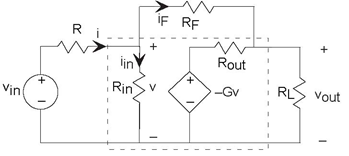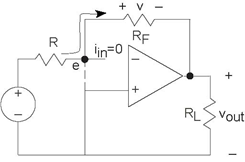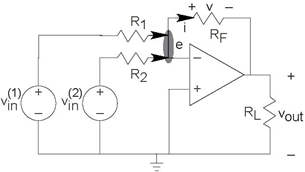When we meet op-amp design specifications, we can simplify our circuit calculations greatly, so much so that we don't need the op-amp's circuit model to determine the transfer function. Here is our inverting amplifier.


When we take advantage of the op-amp's characteristics large input impedance, large gain, and small output impedance we note the two following important facts.
- The current iin must be very small. The voltage produced by the dependent source is 105 times the voltage v. Thus, the voltage v must be
small, which means that
 in must
be tiny. For example, if the output is about 1 V, the voltage v = 10−5V, making the current iin = 10−11 A. Consequently, we can ignore iin in our calculations and assume it to be zero.
in must
be tiny. For example, if the output is about 1 V, the voltage v = 10−5V, making the current iin = 10−11 A. Consequently, we can ignore iin in our calculations and assume it to be zero.
- Because of this assumption essentially no current flow through Rin the voltage v must also be essentially zero. This means that in op-amp circuits, the voltage across the op-amp's input is basically zero.
Armed with these approximations, let's return to our original circuit as shown in Figure 3.46. The node voltage e is essentially zero, meaning that it is essentially tied to the reference node. Thus, the current through the resistor R equals  . Furthermore, the feedback resistor
appears in parallel with the load resistor. Because the current going into the op-amp is zero, all of the current flowing through R flows through the
feedback resistor (iF = i)! The voltage across the feedback resistor v
equals
. Furthermore, the feedback resistor
appears in parallel with the load resistor. Because the current going into the op-amp is zero, all of the current flowing through R flows through the
feedback resistor (iF = i)! The voltage across the feedback resistor v
equals  . Because the left end of the feedback resistor is
essentially attached to the reference node, the voltage across it equals the negative of that across the output resistor:
. Because the left end of the feedback resistor is
essentially attached to the reference node, the voltage across it equals the negative of that across the output resistor:  . Using this approach makes analyzing new op-amp circuits much easier. When using this technique, check
to make sure the results you obtain are consistent with the assumptions of essentially zero current entering the op-amp and nearly zero voltage across the op-amp's inputs.
. Using this approach makes analyzing new op-amp circuits much easier. When using this technique, check
to make sure the results you obtain are consistent with the assumptions of essentially zero current entering the op-amp and nearly zero voltage across the op-amp's inputs.
Example 3.8

Let's try this analysis technique on a simple extension of the inverting amplifier confguration shown in Figure 3.47 (Two Source Circuit). If either of the source-resistor combinations were not present, the inverting amplifier remains, and
we know that transfer function. By superposition, we know that the input-output relation is

When we start from scratch, the node joining the three resistors is at the same potential as the reference,  , and the sum of currents flowing into that node is zero. Thus, the current i flowing in the
resistor RF equals
, and the sum of currents flowing into that node is zero. Thus, the current i flowing in the
resistor RF equals  . Because the feedback resistor is essentially in parallel with the load resistor, the voltages must satisfy v =
−vout. In this way, we obtain the input-output relation given above.
. Because the feedback resistor is essentially in parallel with the load resistor, the voltages must satisfy v =
−vout. In this way, we obtain the input-output relation given above.
What utility does this circuit have? Can the basic notion of the circuit be extended without bound?
- 6454 reads






